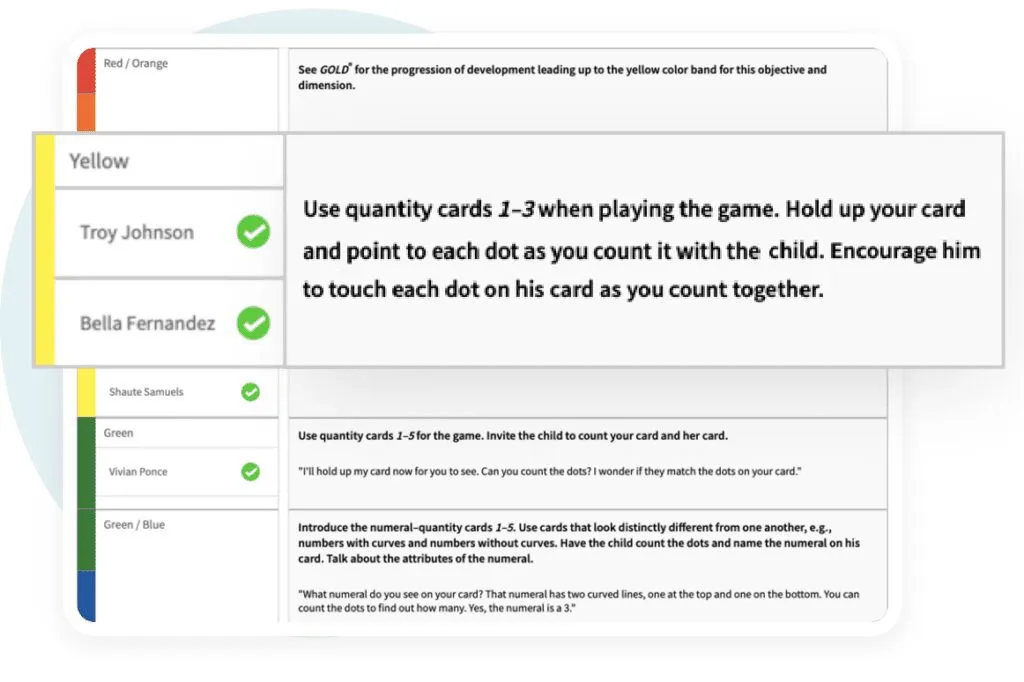Meet Every Child Where They Are
A powerful ecosystem connects curriculum, assessment, family engagement,
and professional development to support children with special needs.
Inform and Document Learning
Easily make modifications and adaptations to instruction and observe evidence of learning.
- Collect observations in the form of videos, images, notes, and children’s work throughout the day.
- Share, communicate, and best support children
with special needs by connecting with their families. - Search a rich library of resources for activities by
skills that need extra support.

Individualize Instruction
Gain insights by connecting assessment data with daily instructional resources automatically.
- Teaching guidance provides insight on how to
empower all children to participate in the same activity. - Color-coded strengths-based Teaching Sequences
outline skill progressions from birth through third grade. - Daily resources provide opportunities for children who have language, speech, physical, or developmental delays to demonstrate learning.

Investigate and Play
Every child, no matter where they are developmentally, brings prior knowledge into the classroom.
- Hands-on, interactive materials and resources allow all children to explore and investigate.
- Studies offer all children the opportunity to investigate and build skills.
- Families easily engage in that learning at home with curated playlists of activities that are sent automatically.

Build Positive Relationships
Create positive, consistent, and responsive classroom routines.
- Dedicated resources help teachers create a positive classroom community and encourage children to build friendships and resolve conflicts.
- Innovative tools help you create trauma-sensitive, relationship-focused learning environments as children build resiliency.

Curriculum
Provide meaningful, individualized, developmentally appropriate learning experiences for children with disabilities.
- Multiple means to modify and adapt instruction to support children with disabilities provided by easy-to-follow, color-coded Teaching Sequences
- Studies of real-world topics to allow all children to participate in the classroom and share their learning experiences with their families
- A searchable library of resources to support all children who may have language, speech, physical, or developmental delays
- And more
Assessment
Embed authentic, observation-based formative assessment that informs a child’s Individual Education Program (IEP).
- Color-coded guidance to individualize instruction informed by progressions that span the entire early childhood development continuum (birth to age 8)
- Automatic feedback loop between curriculum and assessment to meet every child where they are, each day
- At-glance-dashboard with actionable insights to help every child progress
- And more
Professional Development
Provide all teachers the support they need to create the least restrictive environment for children with disabilities.
- An accelerated teacher onboarding program
- A built-in professional learning
community - Embedded guidance and
microlearning - Courses designed to support the teachers of children with special needs
- Autism 101 (English and Spanish)
- Basics of Inclusion (English and Spanish)
- Child Language Development and Signs of Delay (English and Spanish)
- Developmental Milestones (English and Spanish)
- The Nuts and Bolts of Developmental Screening (English)
- Amazing Development: Infants (English)
- Amazing Development: Toddlers (English)
- Amazing Development: Preschool (English)
- And more
Family Engagement
Create seamless transitions for children from home to school by building relationships with their families.
- Family mobile app with customizable, automated playlists filled with developmentally appropriate activities, videos, and books to support each child’s learning at home
- Additional family-friendly activities teachers can share based on each child’s developmental needs
- Two-way communication to connect each child’s two most important worlds: school and home
- And more
Special Education FAQs
There are two primary sources special education funding comes from: the Every Student Succeeds Act (ESSA) and the Individuals with Disabilities Act (IDEA).
The Individuals with Disabilities Education Act (IDEA) is a law that makes a free appropriate public education available to eligible children with disabilities throughout the nation and ensures special education and related services to those children.
UDL principles and practices provide a framework for increasing access to education environments and opportunities, including infant and toddler settings. UDL has three guiding principles.
i. Representation. Children are given a variety of ways to learn new skills and information.
ii. Action and expression. Children are given a variety of ways to demonstrate what they know and can do.
iii. Engagement. Children are empowered to own their learning, with numerous opportunities for choice and autonomy.
Least restrictive environment (LRE) means that to the maximum extent possible, a child with disabilities is educated with children who do not have disabilities.
Inclusion involves supporting students with disabilities through individual learning goals, accommodations, and modifications so that they are able to access the general education curriculum in meaningful ways.
Encourage Children’s Growth
Curriculum, assessment, professional development, and family engagement to support all children.


